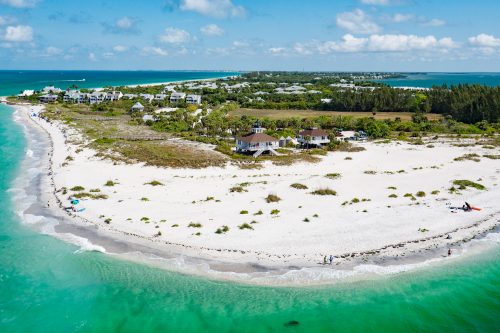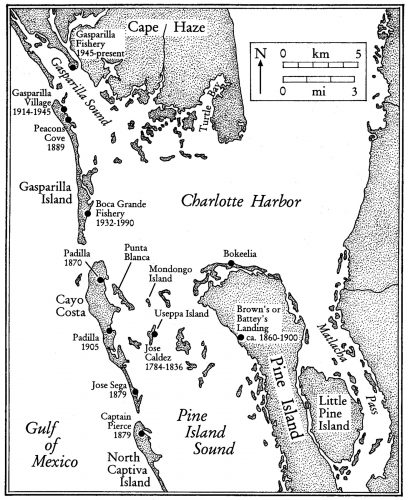Gasparilla Island rises north of Cayo Costa at Boca Grande Pass. It is part of the west-central barrier island chain in the greater Charlotte Harbor region, and is accessible by bridge from Placida.

Gasparilla Island is essential for enclosing the estuary that includes Pine Island Sound. The name “Friar Gaspar” appears on ancient maps drawn long before the mythical pirate was supposed to have lived. The pirate theme first appeared on a railroad brochure in 1904.
Gasparilla Island Geology
The geological evidence suggests that Gasparilla Island is one of the oldest barrier islands in the West-Central portion of the Gulf Coast. Beach rock with shell inclusions indicate that the Gulf of Mexico touched this Florida shoreline as far back as 7,600 years ago.
Gasparilla Island Archaeology
Although archeological exploration of Southwest Florida began in the late 1800s, few archaeologists made it to Gasparilla Island. Only beach-ridges provided clues to possible locations where indigenous people fished. A dozen or more archaeological sites with aboriginal shell middens have been identified among the mangroves on the bay side of the island.
In 1905, antiquarian Clarence Moore explored the remains of one of José Caldéz’s fishing ranchos located on Cayo Pelau, adjacent east of Gasparilla Island. In 1953 archaeologist John M. Goggin and students recorded two sites. In the 1980s anthropologist Robert F. Edic recorded nine indigenous shell middens on shoals and shallow areas on the east side of the now-developed area of Grande Bayou, the widest part of Gasparilla Island, just before bulldozers obliterated them.
Gasparilla Island History

During the Victorian Era, the top three activities on Gasparilla Island were fishing, phosphate loading, and arriving in style. In the 1870s, the ichthyologist George Goode conducted a survey of Gasparilla Island’s lucrative fishery. Located on the northern end of the island, it was run by “Captain Beacon” or Peacon (located in Peacon’s Cove) and thirty “Conchs” from either the Bahamas or Key West. In one year, the fishery produced 550,000 pounds of mullet and 44,000 pounds of roe (fish eggs). Products were salted, processed, and shipped to Cuba where prices were higher.
According to Robert F. Edic in Fisherfolk of Pine Island Sound, local fish products were superior to those produced by Spanish (Cuban) fisheries, which were seasonal, temporary, and sometimes focused on hook-and-line fishing for grouper in deep water. The Peacon’s Cove fishery was permanent, consistent, and focused on net-fishing schools of mullet in the estuary.
In 1897 Albert W. Gilchrist (eventually governor of Florida) filed a plat for a city named Boca Grande on the south end of the island. In 1907 representatives of a railroad company proposed to buy all the land on Gasparilla Island north of a two-mile long military reservation then held by Gilchrist and his partner. The deal was launched through money furnished by the Peace River Phosphate Mining Company. A new plat for Boca Grande was given to the American Agricultural Chemical Company, a phosphate company.
By 1920, three million tons of phosphate, a key component of fertilizer, was being mined in “Bone Valley,” an area within Polk, DeSoto, Mantatee, and Hardy Counties, producing 90 percent of the world’s fertilizer. A phosphate port facility was built on the east side of Boca Grande Pass for ocean-going vessels. Phosphate arrived via the Charlotte Harbor and Northern Railway (CHN), or “Cold, Hungry, and Naked” according to workers who joked about the low pay.
The railroad also shipped iced fish in insulated boxcars from Gasparilla fisheries. Around 1916, ice houses on stilts over water were built for storage on the northeast side of the island as ice replaced the salt method of preserving fish.
In 1913, the two-year old “Hotel Boca Grande” (not to be confused with a later hotel) was renamed Gasparilla Inn. Beachfront cottages attracted prominent industrialists of the day, some of whom arrived in huge sailing yachts. Gasparilla Inn continues to host modern dignitaries.
Bone Valley today still produces about 75 percent of the nation’s supply of phosphate, and about 25 percent of the world’s fertilizer, but not through Port Boca Grande since 1979. The railroad line through the center of Boca Grande is now a bike and golf cart path. Visitors can bask at Gasparilla State Park and find an interesting museum inside the newly refurbished Port Boca Grande Lighthouse.
This article was adapted from A Tour of the Islands of Pine Island Sound, Florida, by Denége Patterson.
This article was taken from the Friends of the Randell Research Center Newsletter Vol 17, No. 4. December 2018.